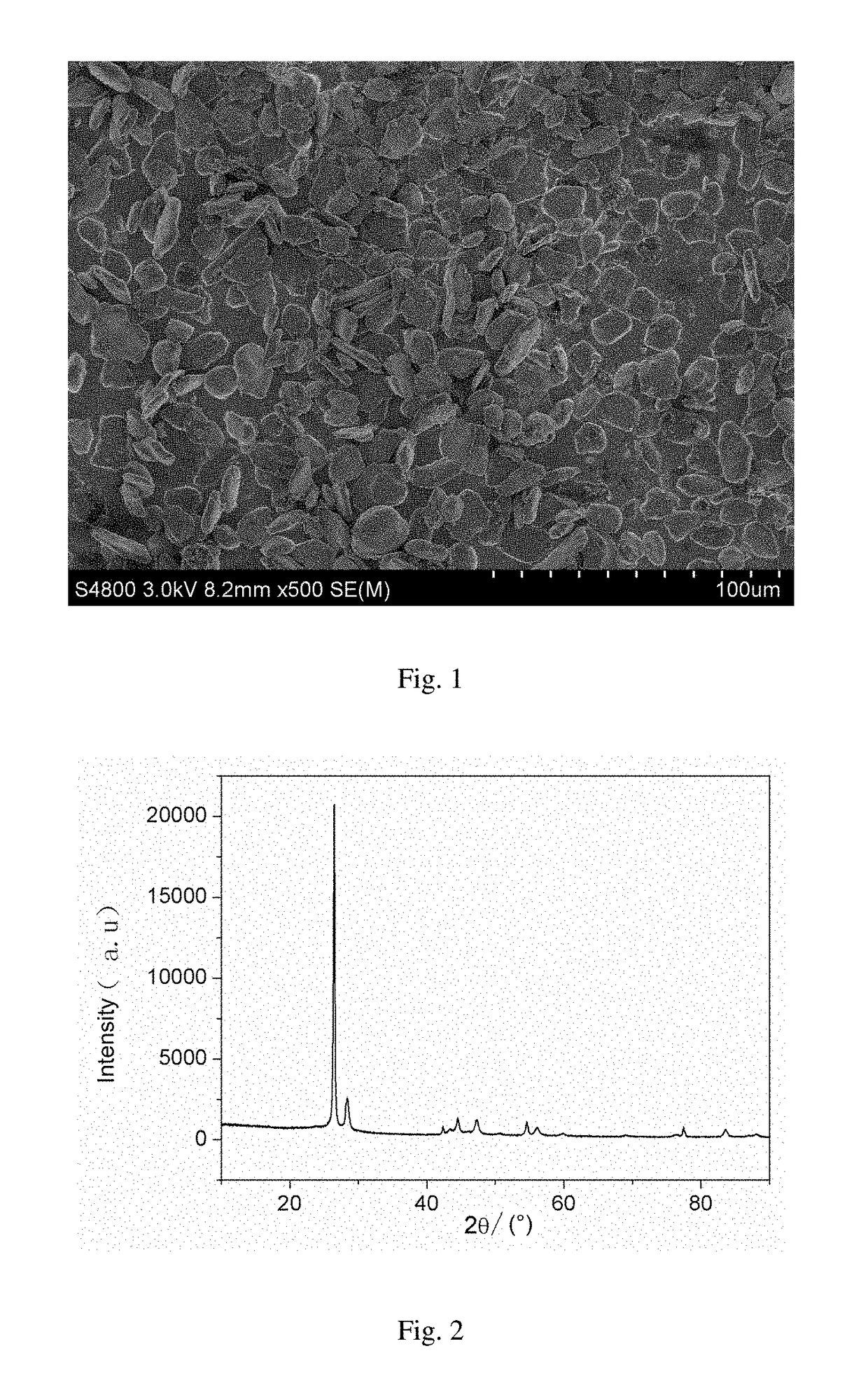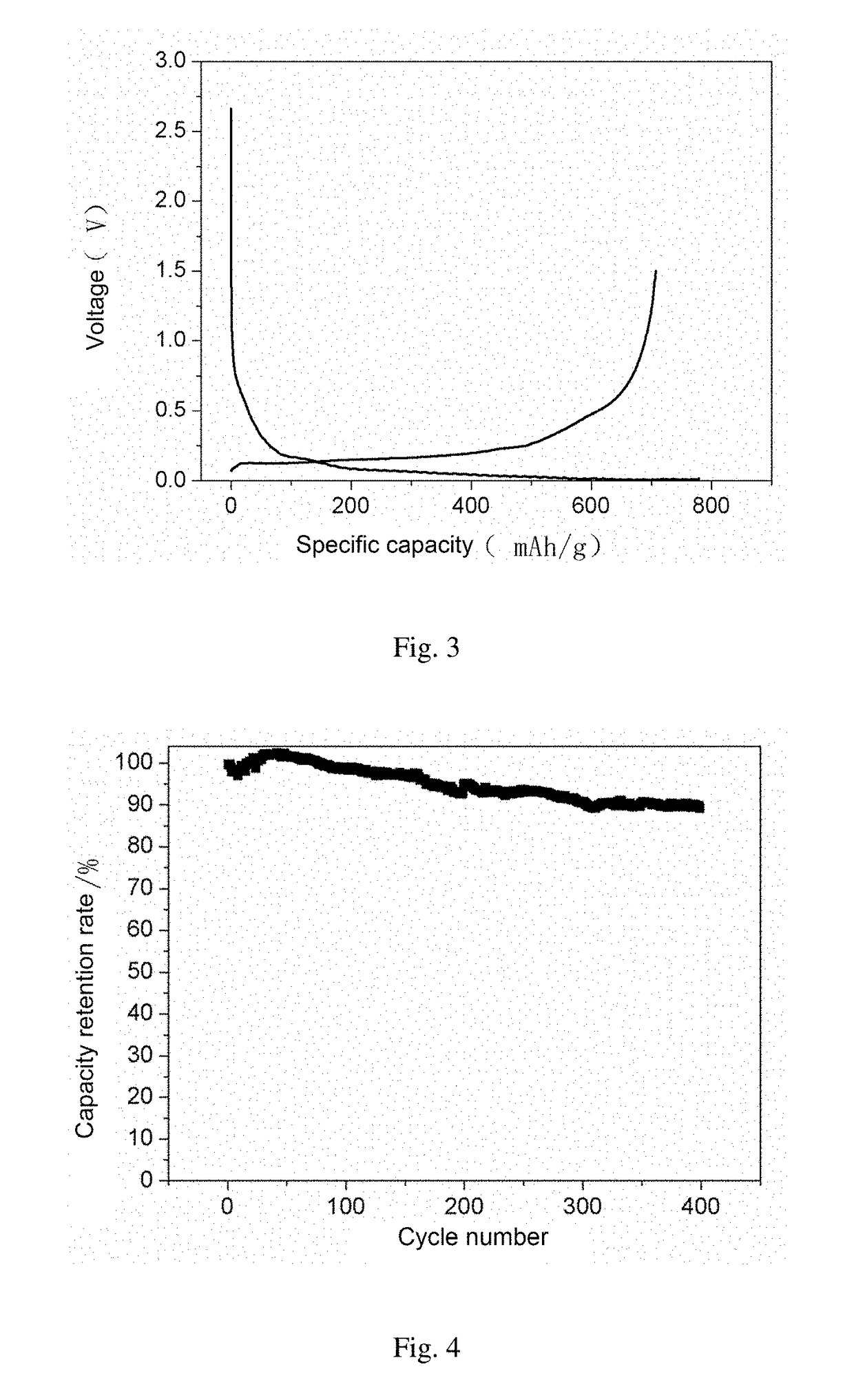Multiple-Element Composite Material For Anodes, Preparation Method Therefor, And Lithium-Ion Battery Having Same
- Summary
- Abstract
- Description
- Claims
- Application Information
AI Technical Summary
Benefits of technology
Problems solved by technology
Method used
Image
Examples
example 1
[0078]Spheroidal natural graphite having a particle size of 5-20 μm, Si having a particle size of 30-250 nm and polyoxyethylene sorbitan monooleate in a mass ratio of 80:5:0.5 were dispersed in propanol, rotary-evaporated and dried to obtain a first precursor. The first precursor and graphene in a mass ratio of 85:5 were placed in a fusion machine, and fused for 0.5 h, and then placed in a box furnace, wherein the rotating speed was adjusted to 3000 r / min; the gap width of the cutting tool was 0.01 cm. Argon was fed, and the temperature was increased to 600° C. at a rate of 0.5° C. / min, and kept for 10.0 h. Natural cooling was carried out to room temperature to obtain a second precursor. The second precursor, Si having a particle size of 30-250 nm and fatty acid polyglycol esters in a mass ratio of 90:5:0.2 was dispersed in ethanol, spray-dried to obtain a third precursor. The third precursor and asphalt powder having a particle size of 0.1-6.0 m in a mass ratio of 95:20 were placed...
example 2
[0081]Spherical artificial graphite having a particle size of 10.0-30.0 m was placed in a rotary furnace, and the rotating speed was adjusted to 0.1 r / min. Argon was fed, and the temperature was increased to 800° C. at a rate of 1.0° C. / min. Then silane gas was fed in a gas flow rate of 0.5 L / min. The temperature was kept for 5.0 h, and then natural cooling was proceeded to room temperature to obtain a first precursor. The first precursor and polyvinyl alcohol in a mass ratio of 80:20 was dispersed in methanol, spray-dried and then placed in a tube furnace. Argon was fed, and the temperature was increased to 900° C. at a rate of 0.5° C. / min, and kept for 0.5 h. Natural cooling was carried out to room temperature to obtain a second precursor. The second precursor was placed in a rotary furnace, and the rotating rate was adjusted to 0.5 r / min. Argon was fed, and the temperature was increased to 800° C. at a rate of 10.0° C. / min. Then silane gas was fed in a gas flow rate of 1.0 L / min....
example 3
[0082]SiO0.4 having a particle size of 50-300 nm and spherical natural graphite having a particle size of 10-25 μm in a mass ratio of 10:30 were placed in a fusion machine, and fused for 0.5 h, wherein the rotating speed was adjusted to 2000 r / min; the gap width of the cutting tool was 0.5 cm, to obtain a first precursor. The first precursor was placed in a rotary furnace, wherein the rotating speed was adjusted to 3.0 r / min. Argon was fed, and the temperature was increased to 700° C. at a rate of 5.0° C. / min. Then acetylene gas was fed in a flow rate of 1.0L / min, and the temperature was kept for 2.0 h. Natural cooling was carried out to room temperature to obtain a second precursor. SiO0.4 having a particle size of 50-300 nm and the second precursor in a mass ratio of 10:80 were placed in a fusion machine, and fused for 1.0 h, wherein the rotating speed was adjusted to 3000 r / min; the gap width of the cutting tool was 0.5 cm, to obtain a third precursor. The third precursor and asp...
PUM
| Property | Measurement | Unit |
|---|---|---|
| Temperature | aaaaa | aaaaa |
| Temperature | aaaaa | aaaaa |
| Time | aaaaa | aaaaa |
Abstract
Description
Claims
Application Information
 Login to View More
Login to View More - R&D
- Intellectual Property
- Life Sciences
- Materials
- Tech Scout
- Unparalleled Data Quality
- Higher Quality Content
- 60% Fewer Hallucinations
Browse by: Latest US Patents, China's latest patents, Technical Efficacy Thesaurus, Application Domain, Technology Topic, Popular Technical Reports.
© 2025 PatSnap. All rights reserved.Legal|Privacy policy|Modern Slavery Act Transparency Statement|Sitemap|About US| Contact US: help@patsnap.com


